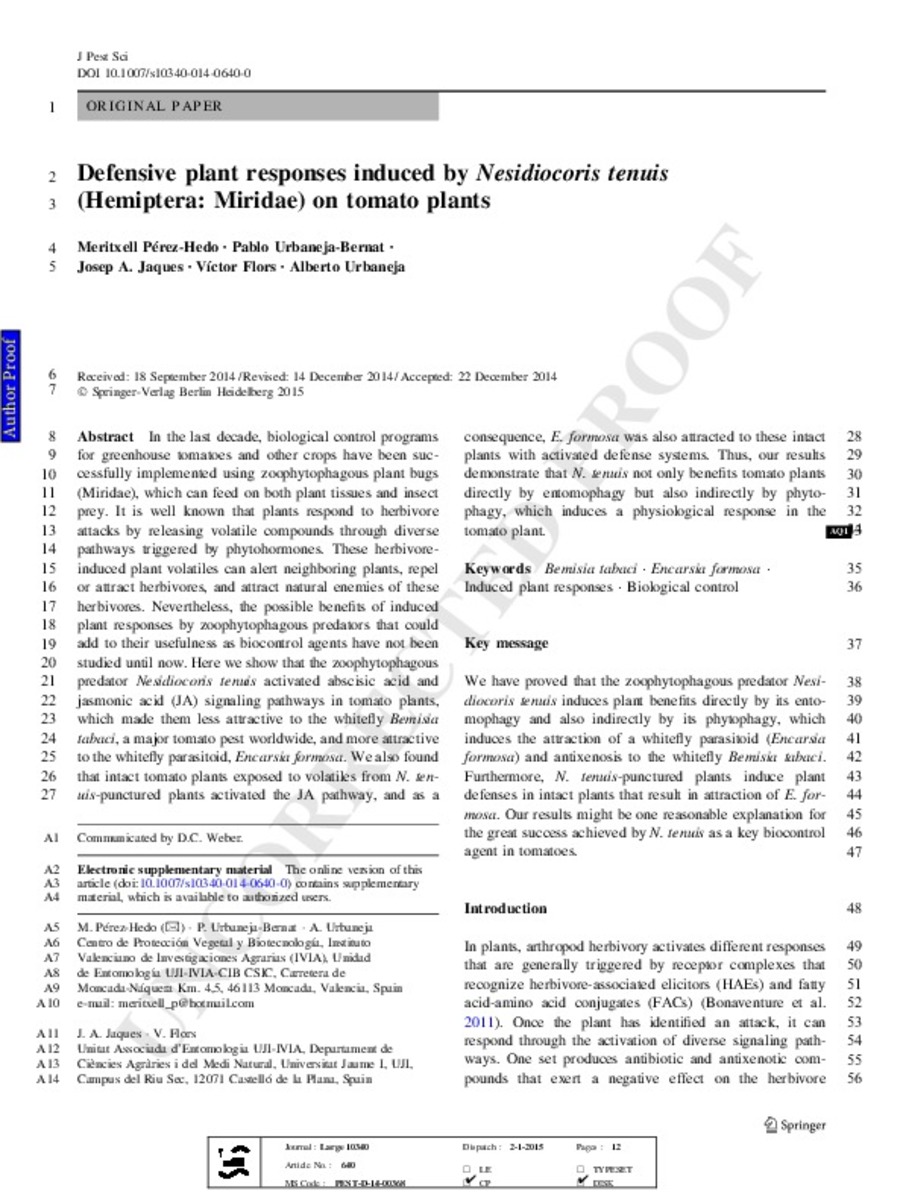Mostrar el registro sencillo del ítem
Defensive plats responses induced by Nesidiocoris tenuis (Hemiptera:Miridae) on tomato plants
| dc.contributor.author | Perez-Hedo, Meritxell | |
| dc.contributor.author | Urbaneja-Bernat, Pablo | |
| dc.contributor.author | Jaques , Josep A. | |
| dc.contributor.author | Flors, Victor | |
| dc.contributor.author | Urbaneja, Alberto | |
| dc.date.accessioned | 2016-04-14T10:07:36Z | |
| dc.date.available | 2016-04-14T10:07:36Z | |
| dc.date.issued | 2015-01 | |
| dc.identifier.citation | PÉREZ-HEDO, Meritxell, et al. Defensive plant responses induced by Nesidiocoris tenuis (Hemiptera: Miridae) on tomato plants. Journal of Pest Science, 2015, vol. 88, no 3, p. 543-554. | ca_CA |
| dc.identifier.uri | http://hdl.handle.net/10234/158565 | |
| dc.description.abstract | In the last decade, biological control programs for greenhouse tomatoes and other crops have been successfully implemented using zoophytophagous plant bugs (Miridae), which can feed on both plant tissues and insect prey. It is well known that plants respond to herbivore attacks by releasing volatile compounds through diverse pathways triggered by phytohormones. These herbivore-induced plant volatiles can alert neighboring plants, repel or attract herbivores, and attract natural enemies of these herbivores. Nevertheless, the possible benefits of induced plant responses by zoophytophagous predators that could add to their usefulness as biocontrol agents have not been studied until now. Here we show that the zoophytophagous predator Nesidiocoris tenuis activated abscisic acid and jasmonic acid (JA) signaling pathways in tomato plants, which made them less attractive to the whitefly Bemisia tabaci, a major tomato pest worldwide, and more attractive to the whitefly parasitoid, Encarsia formosa. We also found that intact tomato plants exposed to volatiles from N. tenuis-punctured plants activated the JA pathway, and as a consequence, E. formosa was also attracted to these intact plants with activated defense systems. Thus, our results demonstrate that N. tenuis not only benefits tomato plants directly by entomophagy but also indirectly by phytophagy, which induces a physiological response in the tomato plant. | ca_CA |
| dc.description.sponsorShip | The research leading to these results was funded by the European Union Seventh Framework Programme (FP7/2007–2013) under grant agreement no. 265865, the Spanish Ministry of Science and Innovation (AGL2011-30538-C03) and the Conselleria d’Agricultura, Pesca i Alimentació de la Generalitat Valenciana. The authors thank Virginia Pedroche (IVIA) and Blas Agut (UJI) for their technical assistance, Javier Calvo (KOPPERT BS) for the supply of insects, Universitat Jaume I-SCIC for technical support and two anonymous reviewers for their valuable comments on a previous version of this manuscript. | ca_CA |
| dc.format.extent | 11 p. | ca_CA |
| dc.language.iso | eng | ca_CA |
| dc.publisher | Springer | ca_CA |
| dc.relation.isPartOf | Journal of Pest Science September 2015, Volume 88, Issue 3 | ca_CA |
| dc.rights | © Springer-Verlag Berlin Heidelberg 2015 | ca_CA |
| dc.rights.uri | http://rightsstatements.org/vocab/InC/1.0/ | * |
| dc.subject | Bemisia tabaci | ca_CA |
| dc.subject | Encarsia formosa | ca_CA |
| dc.subject | Induced plant responses | ca_CA |
| dc.subject | Biological control | ca_CA |
| dc.title | Defensive plats responses induced by Nesidiocoris tenuis (Hemiptera:Miridae) on tomato plants | ca_CA |
| dc.type | info:eu-repo/semantics/article | ca_CA |
| dc.identifier.doi | http://dx.doi.org/10.1007/s10340-014-0640-0 | |
| dc.rights.accessRights | info:eu-repo/semantics/openAccess | ca_CA |
| dc.relation.publisherVersion | http://link.springer.com/article/10.1007/s10340-014-0640-0 | ca_CA |
Ficheros en el ítem
Este ítem aparece en la(s) siguiente(s) colección(ones)
-
CAMN_Articles [566]







